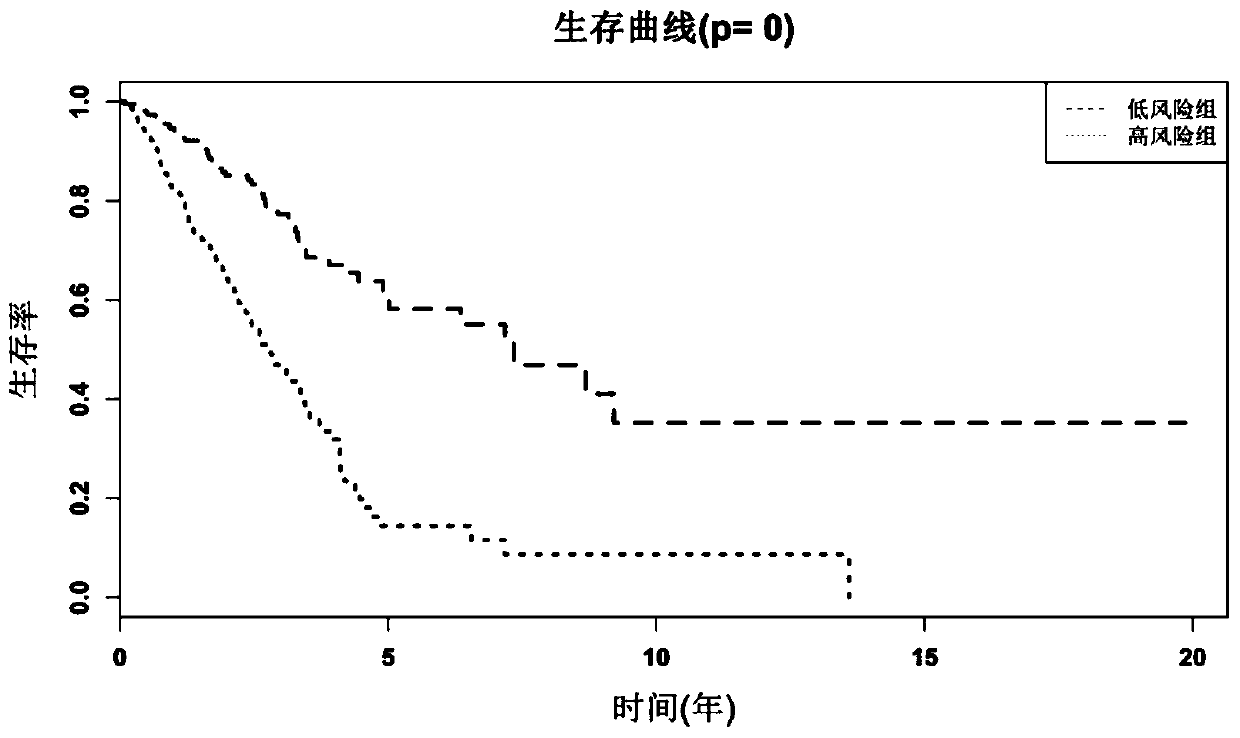A prognostic marker for lung cancer, method and application of using the marker to predict the prognosis of lung cancer
A prognostic marker and marker technology, applied in the field of biomedicine, can solve problems such as loss of data, achieve high clinical application value and save medical costs.
- Summary
- Abstract
- Description
- Claims
- Application Information
AI Technical Summary
Problems solved by technology
Method used
Image
Examples
Embodiment 1
[0054] Taking lung adenocarcinoma as an example, the establishment of a prognosis prediction model for lung adenocarcinoma:
[0055] 1) Download lung adenocarcinoma data from TCGA, including transcriptome data and clinical survival data, a total of 515 samples;
[0056] 2) Remove samples with incomplete clinical data, such as incomplete follow-up data, leaving 464 samples; the follow-up survival time data of patients included in the present invention is the earliest from 1986, and the latest is 2016;
[0057] 3) Use the DESeq R package to compare the gene expression between normal people and cancer patients (screening conditions: |log2FC|>2, padj<0.001), and get 1618 differentially expressed genes; the main code for DESeq to find differential genes is as follows:
[0058] >library("DESeq")
[0059] >group=c(rep("normal",num1),rep("tumor",num2))
[0060] >design = factor(group)
[0061] >newTab = newCountDataSet( data, design )
[0062] >newTab = estimateSizeFactors(newTab)...
Embodiment 2
[0078] The prognostic markers of lung adenocarcinoma include the following gene combinations: RP11-89K21.1, CDH17, GRIA1, CENPF, AP000438.2, HMMR, RP11-434D9.1, ADH1B, TPX2, OR7E47P, and the sequences of the genes are SEQ ID NO: 1-10.
[0079] According to Example 1, we have screened out the above prognostic markers, and the prognostic prediction model of lung cancer is:
[0080] S=∑Pi * Ci
[0081] Among them, S is the prognostic risk value of lung cancer, Pi is the quantitative expression value of the i-th gene, and Ci represents the COX regression coefficient of the i-th gene, i=1,2,3,4...10.
[0082] In the prognosis prediction model of lung cancer, the COX regression coefficient corresponding to each gene is selected from the following table:
[0083]
[0084] A method for predicting the prognosis of lung cancer, comprising the following steps:
[0085] 1) Collect samples from lung cancer patients, detect and obtain the expression levels of prognostic markers of lun...
Embodiment 3
[0092] Prognostic markers for lung adenocarcinoma included the following gene combinations: RP11-89K21.1, CDH17, GRIA1, CENPF, AP000438.2, HMMR, RP11-434D9.1, ADH1B, TPX2, OR7E47P, GPR37, HABP2, the The sequences are SEQ ID NO: 1-12 in turn.
[0093] In the prognosis prediction method of lung cancer, the reference value is 1.02.
[0094] According to Example 1, we have screened out the above prognostic markers, and the prognostic prediction model of lung cancer is:
[0095] S=∑Pi * Ci
[0096] Among them, S is the prognostic risk value of lung cancer, Pi is the quantitative expression value of the i-th gene, and Ci represents the COX regression coefficient of the i-th gene, i=1,2,3,4...12.
[0097] In the prognosis prediction model of lung cancer, the COX regression coefficient corresponding to each gene is selected from the following table:
[0098]
[0099] A method for predicting the prognosis of lung cancer, comprising the following steps:
[0100] 1) Collect sample...
PUM
 Login to View More
Login to View More Abstract
Description
Claims
Application Information
 Login to View More
Login to View More - R&D
- Intellectual Property
- Life Sciences
- Materials
- Tech Scout
- Unparalleled Data Quality
- Higher Quality Content
- 60% Fewer Hallucinations
Browse by: Latest US Patents, China's latest patents, Technical Efficacy Thesaurus, Application Domain, Technology Topic, Popular Technical Reports.
© 2025 PatSnap. All rights reserved.Legal|Privacy policy|Modern Slavery Act Transparency Statement|Sitemap|About US| Contact US: help@patsnap.com



